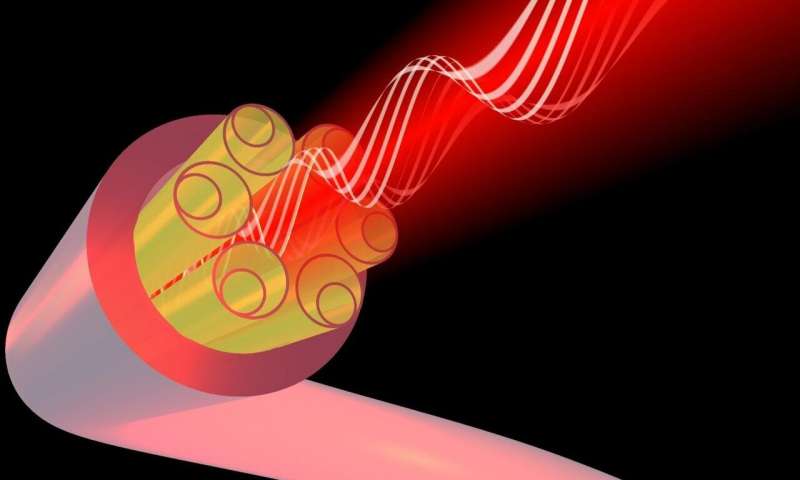
Researchers have taken an
important new step in advancing the performance of resonator fiber optic
gyroscopes, a type of fiber optic sensor that senses rotation using only light.
Because gyroscopes are the basis of most navigation systems, the new work could
one day bring important improvements to these systems.
"High-performance gyroscopes are used for navigation in many types of air, ground, marine and space applications," said Glen A. Sanders, who led the research team from Honeywell International. "Although our gyroscope is still in the early stages of development, if it reaches its full performance capabilities it will be poised to be among the next generation of guidance and navigation technologies that not only push the bounds of accuracy but do so at reduced size and weight."
In The Optical Society (OSA) journal Optics Letters, researchers from Honeywell and the University of Southampton's Optoelectronics Research Centre in the UK describe how they used a new type of hollow core optical fiber to overcome several factors that have limited previous resonator fiber optic gyroscopes. This allowed them to improve the most demanding performance requirement of the gyroscope stability by as much as 500 times over previously published work involving hollow core fibers
"We hope to see these gyroscopes used in the next-generation of civil aviation, autonomous vehicles and the many other applications in which navigation systems are employed," said Sanders. "Indeed, as we enhance the performance of guidance and navigation systems, we hope to open entirely new capabilities and applications."
Sensing rotation with light
Resonator fiber optic gyroscopes use two lasers that travel through a coil of optical fiber in opposite directions. The ends of the fiber are connected to form an optical resonator so that most of the light will recirculate and take multiple trips around the coil. When the coil is at rest, the light beams traveling in both directions share the same resonance frequency, but when the coil is rotating, the resonance frequencies shift relative to each other in a way that can be used to calculate the direction of movement or orientation for the vehicle or device on which the gyroscope is mounted.
Honeywell has been developing resonator fiber optic gyroscope technology for some time because of its potential to deliver high accuracy navigation in a smaller size device compared to current sensors. However, it has been challenging to identify an optical fiber that can withstand the even modest laser power levels at the ultra-fine laser linewidths required by these gyroscopes without causing nonlinear effects that degrade the sensor's performance.
"In 2006, we proposed using a hollow core fiber for the resonator fiber optic gyroscope," said Sanders. "Because these fibers confine the light in a central air or gas-filled void, sensors based on them don't suffer from the nonlinear effects that plague sensors based on solid fibers."
Using an even better fiber
In the new work, led by Austin Taranta at the University of Southampton, the researchers wanted to see if an entirely new type of hollow core fiber could bring even more improvements. Known as nodeless antiresonant fiber (NANF), this new class of fibers exhibits even lower levels of nonlinear effects than other hollow core fibers.
NANFs also have low optical attenuation, which improves the quality of the resonator because the light maintains its intensity over longer propagation lengths through the fiber. In fact, these fibers have been shown to have the lowest light loss of any hollow core fiber, and for many parts of the spectrum, the lowest loss of any optical fiber.
For resonator fiber optic gyroscopes, it is crucial that the light travels only in a single path through the fiber. The NANFs help make this possible by eliminating optical errors caused by backscattering, polarization coupling and modal impurities, which are all potential sources of error or extra noise in the gyroscope. Their elimination removes the most significant performance limiters for other fiber technologies.
"Although the backbone of this sensor is the new type of optical fiber, we also worked to greatly reduce noise when sensing the resonance frequency with unprecedented accuracy," said Sanders. "This was crucial for enhancing the performance and moving toward miniaturizing the sensor."
Achieving long-term stability
The Honeywell researchers performed laboratory studies to characterize the performance of the new fiber optic gyroscope sensor under stable rotation conditions, i.e., only in the presence of Earth's rotation. This establishes the instrument's "bias stability". To eliminate noise and disturbances in the free-space optical setup, the gyroscope was mounted on a stable, static pier. By incorporating the NANFs, the researchers were able to demonstrate a long-term bias stability of 0.05 degrees per hour, which is close to the levels required for civil aircraft navigation.
"By demonstrating the high performance of NANFs in this extremely demanding application, we hope to show the exceptional promise of these fibers for use in other precision scientific resonant cavities," said Taranta.The researchers are now working to make a prototype gyroscope with a more compact and stable configuration. They also plan to incorporate the latest generation NANFs, which exhibit a four times improvement in optical losses, along with greatly improved modal and polarization purity.

 Previous page
Previous page Back to top
Back to top







